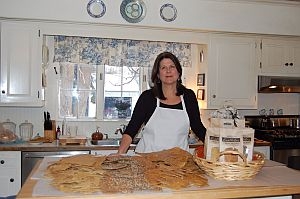
(Host) Eating locally produced food has become much more popular. And small, specialty food producers are on the rise nationwide. In Vermont there are more than 400 food-related companies.
While it may be easy to start a food business, growing one and keeping it local is more difficult.
VPR’s Nina Keck reports on efforts in Rutland to help regional food entrepreneurs succeed.
(Keck) Whitney Lamy was a fixture last year at Rutland’s indoor farmers’ market.
"Would you like to try some crackers? This is wheat, rhye and maple. . . .
(Keck) Lamy used the weekly venue to launch her new business, Castleton Crackers.
(Lamy) "And for $25, I could set up a table and see if people liked my crackers. I could go every week. And were people coming back? What were the comments? Was the price point right? I think it was just an amazing way to start a business without thousands and thousands of dollars and the risks involved."
(Keck) Many small scale food producers in Vermont start the same way. But Lamy was luckier than most. Demand for her crackers quickly grew. She hired a food distributor; invested in nutrition labels and checkout codes. Within a few months, Castleton crackers were available all over Vermont and beyond.
(Lamy) "All the while I was still making my crackers in my home kitchen and it just got to the point that I couldn’t keep up with the orders."
(Keck) So she began looking for a commercial kitchen or co-packing facility to make and package her crackers for her.
(Lamy) "What was heart-breaking for me was coming up again and again against a brick wall of trying to find a co-packer in the state of Vermont. And the more I researched the more I learned that many food companies in Vermont, as they grow, have to leave the state, which is ironic because Vermont specialty food industry is huge."
(Keck) Sharon Myers understands that scenario all too well. A long time caterer in Brattleboro, she, too, had trouble finding a Vermont facility to make her specialty marmalades and chutneys. She finally gave up and contracted with a co-packer 20 minutes away in Greenfield, Massachusetts.
(Myers) "It was hard because I would join all these Vermont food organizations and someone would say all the products have to be made in Vermont and I wasn’t lying to anybody. I said, "I’m in Vermont, I sell out of Vermont, and my product is made in Greenfield.’ And I ran into people who sort of just looked at me like, `Well, that’s not honest.’ But I couldn’t find a place here that would do it."
(Crosby) "My name is Kim Crosby, and I’m the owner and President of Vermont Roots, a distributor of Vermont specialty products. So we specialize in carrying things that are made here in Vermont and also helping the entrepreneur who is looking to start a business, to build a business to get them up and running and get them going."
(Keck) Crosby stands in her Rutland warehouse as an employee unloads a truck. She says 30 to 40 percent of a grocery store’s business is now in the specialty food division. So it’s a good time for innovative entrepreneurs. While she says there are several commercial co-packing facilities in Vermont, not all are equipped to make every product and most require a minimum of 50 cases. That can be daunting. Because of that, many small food businesses turn to the Vermont Food Venture Center in Fairfax. It’s a nonprofit, small business incubator that provides much needed technical support. There are plans to move that facility to Hardwick in the Northeast Kingdom. But that still leaves much of the state underserved. Governor Douglas set aside $1 million from last year’s budget hoping to help other parts of the state develop other innovative kitchens. Kim Crosby hopes some of that money will be put to work in Rutland.
(Crosby) "So myself, and a group of people have looked at taking on and building a commercial kitchen here with myself as a distributor and anchor so something we could have an opportunity to grow off of."
(Keck) Rutland received an $18,000 planning grant to jump start the process and several different business models are being considered. Jamie Stewart, of the Rutland Economic Development Corporation, is excited by the project’s potential for job growth.
(Stewart) "A lot of these businesses, they tend to be small, they tend to be three, four, six, eight maybe 10 employees. Occasionally they may be bigger. But if we can have these solid four-, five-, six-, eight- person businesses, they are in the communities, and they create a great workplace for the employees and comfortable livings for people here in Vermont. So there’s a nice quality and a match that comes with this."
(Keck) Even if Rutland is awarded state funding, Stewart says additional money will likely be needed, as will a highly skilled manager to ensure the project’s sustainability. Kim Crosby agrees. But she’s hopeful that if state and private funding come through, they’ll have a commercial kitchen up and running by October.
For VPR News, I’m Nina Keck in Rutland.